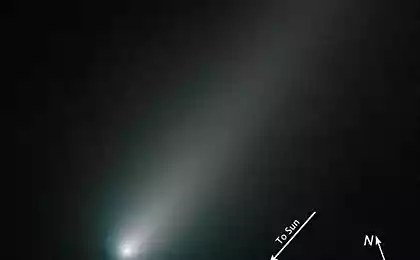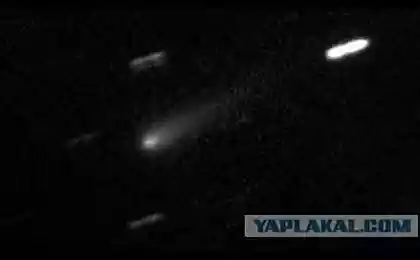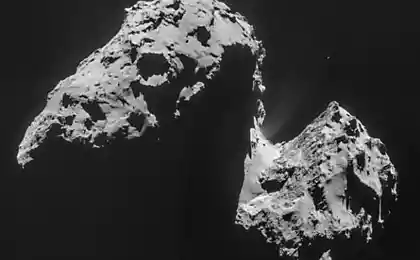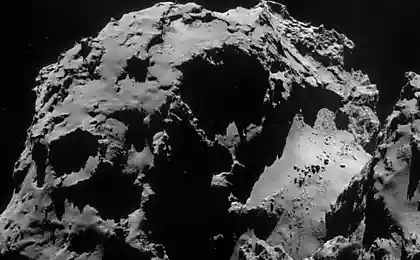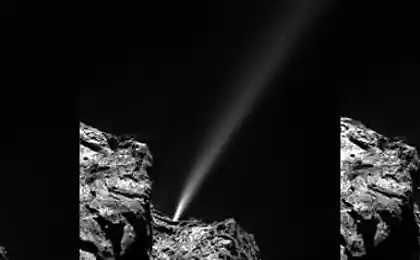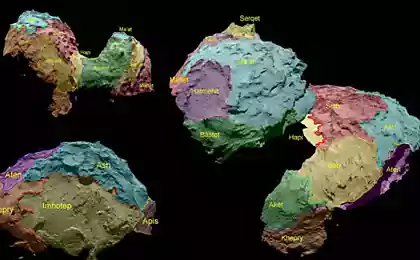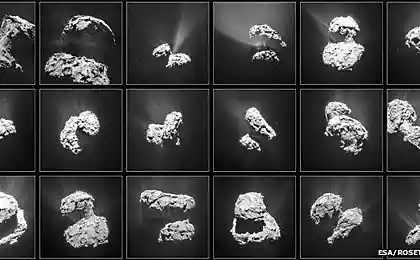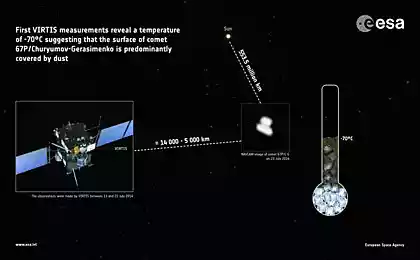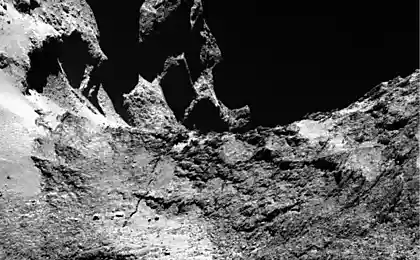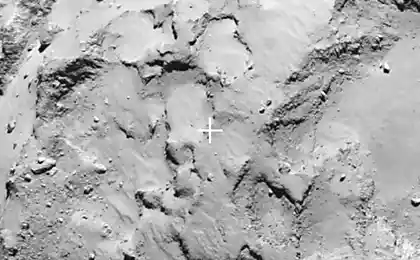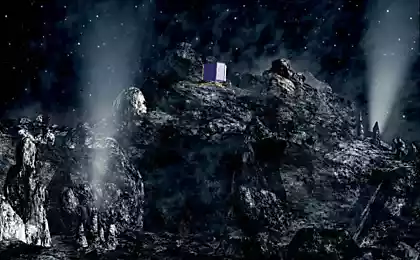Comets. Icebergs solar system
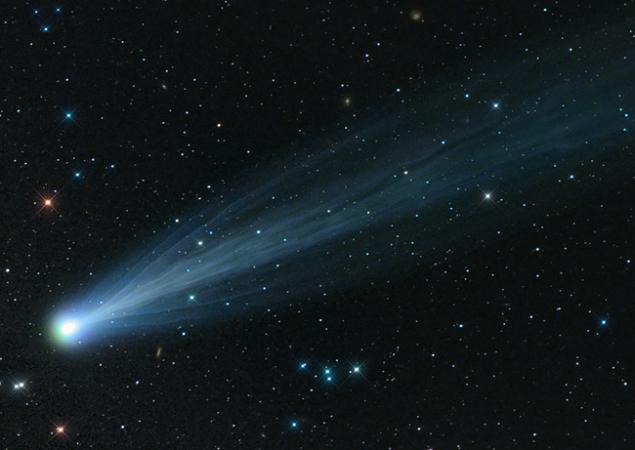
The most interesting news this week, the space is deservedly considered the meeting of the European probe Rosetta to the comet 67P / Churyumov-Gerasimenko . This comet, measuring 3-5 km far from the only one that honored the immediate attention of interplanetary spacecraft. However, there is every reason to believe this meeting and hopefully sign historic.
Mission Rosetta probe is a logical consequence of the special, and you can tell the mystical, the interest of humanity to the "shaggy» (komḗtēs) luminaries as these celestial bodies named by the ancient Greeks. Below we analyze in a popular form of human knowledge about the cosmic "iceberg", and try to understand the huge interest in him from the scientific community.
Punctual "gorevestnitsa» h5> The history of documented observations of comets dates back several thousand years, the most detailed description of the appearance of the "shaggy" of light can be found in ancient Chinese chronicles.
Even then, the appearance of these stars was associated with mystical and often tragic events. So the appearance of a bright comet in 240g do.n.e. It was interpreted as a sign of the imminent demise of the Chinese empress. The same comet manifested in the sky above Rome in 12g do.n.e. already "prejudge" the fate of Agrippa, a close friend and son of Emperor Augustus. In the 6th century, it is "started a" drought and unrest in the Byzantine Empire, and in 1066g, in the opinion of contemporaries, unequivocally condemned the invasion of England by William the Conqueror, Duke of Normandy.
Halley's Comet on the Bayeux tapestry, 1066 i>
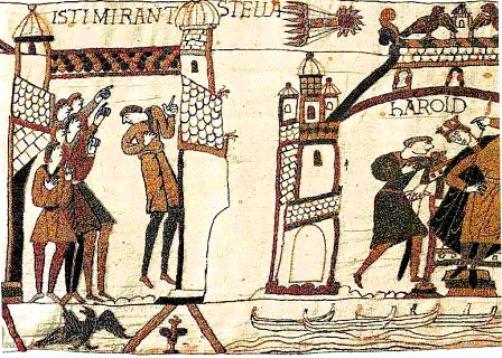
However, this comet was destined to play a very important role in the history of science. In 1682, English astronomer Edmund Halley, calculating the orbit they observed a bright comet, observed that it coincides with the orbits of comets in 1531 and 1607g. Assuming that we are talking about one and the same comet, he predicted its appearance at perigee (closest point to the sun's orbit) in 1758.
Her appearance with a month delay in the 1759g was more than enough to recognize the triumph of Newton's theory of gravitation. Halley's Comet is now in the first line of a huge list of observed since comets. Its index 1P / 1682 indicates that it is the first of comets "returning" to the Sun refers to the group R - short-period comets, and was opened in 1682g.
The parameters of the orbit of Halley's Comet i>
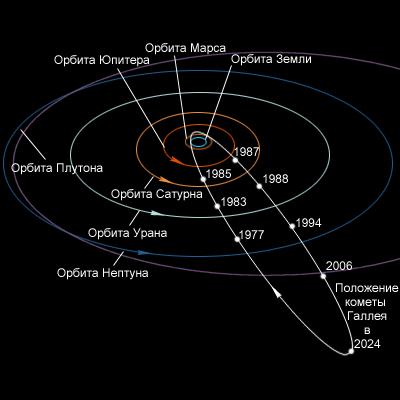
Again, thanks to Halley's Comet, which was held on the disk of the Sun in 1910, astronomers were able to estimate the approximate size of cometary nuclei, it was less than 20 km. Simultaneously, the first time was made a spectral analysis of the tail "shaggy" luminaries turned out rich poisonous cyanogen and carbon monoxide. What caused great panic in the same year when the Earth passed through the tail of the comet itself groundless.
The image of Halley's comet in 1910 i>
By the next arrival of a comet in 1986, humanity is no longer limited to observations from Earth (rather unfavorable in that year). On the "interception" Space "iceberg" went a flotilla of spacecraft. The composition of "Halley Armada" was as follows:
Halley's Comet in 1986, i>
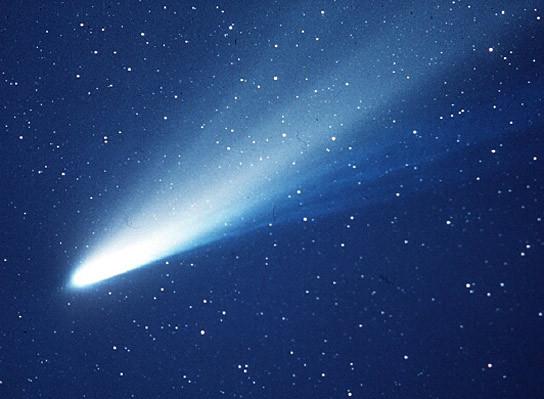
- Two Soviet probe «Vega 1" and "Vega 2» , flown a distance of about 9000 km from the comet's nucleus, constituting 3D map of the kernel and transmits 1500 images (picture below).

- European probe "Giotto", reach the nucleus at a distance of 605 km, thanks to the help of the Soviet navigation devices (photo below).
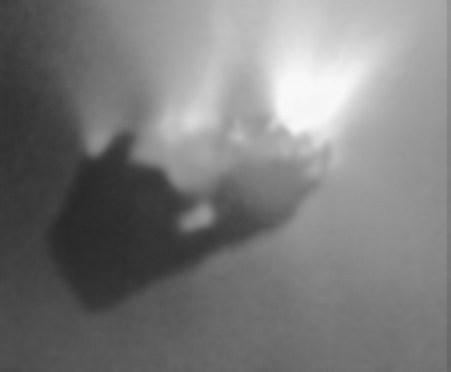
- Two Japanese probe "Suysey" and "Sakigake", approached the kernel to 150,000 km and 7 million respectively.
- ISEE-3 (ICE) studied the tail of Halley's comet with the Lagrange point L1 (the Earth-Sun).
Illustration "Halley Armada" that studied a comet in 86 g i>
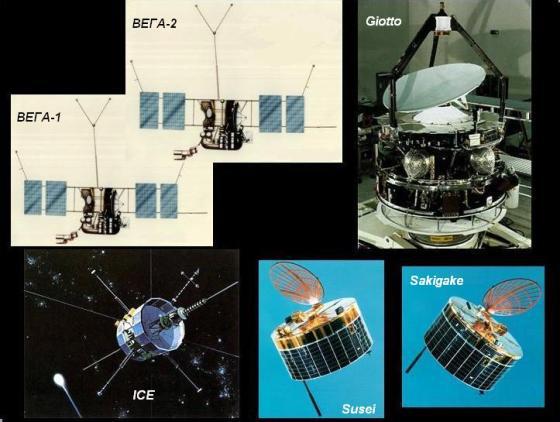
It received a huge amount of information about the cometary matter, taken thousands of pictures of the nucleus. Evaluation of the size of the nucleus of comet observations confirmed 1910 - the core of irregularly shaped 15/8 km. Get more experience on the interaction of various space agencies, in solving complex technological problems.
Unfortunately, long-awaited by the scientific community, "the year of Halley's Comet" was marred by two man-made disasters - the death of the crew of the "Challenger" and the Chernobyl accident.
In addition to Halley's comet, astronomers have observed thousands of account for the last 300 years of comets. The cores have a size of several tens of meters to tens of kilometers and are a mixture of dust and ice, mostly water, ammonia and / or methane (the so-called model of "dirty snowballs" Whipple). However, it is evident that many cores can to some extent deviate from this model. So space probe Deep impact, dropped the "bomb" on the comet Tempel 1 in 2005, revealed that the comet is composed mainly of a porous skeleton dust.
«Bombing" Comet Tempel probe Deep impact and the subsequent passage of the comet probe about Stardust i>
As the primary building material preserved building blocks of the solar system, comets are of great interest for geology, chemistry and biology. Presumably comets brought to Earth in ancient times the bulk of its water of the hydrosphere. The spectral lines of many comets discovered complex organic compounds down to amino acids and urea. Scientists believe that comets, as incubators of complex organic compounds that could bring to Earth a chemical basis for the emergence of life. Blockquote>
Approaching the perihelion, comet nucleus, under the influence of solar radiation, start spewing huge amounts of gas, bypassing the liquid state of aggregation tayaschego ice (sublimation). Gases in turn entrain the large mass of dust mixed in the ice, which together with the ice particles blown off under the influence of solar radiation and the wind, the opposite side of the star.
The size of comet "tails" can reach several hundreds of millions of kilometers long. So, in 1996, the space probe «Ulysses» (NASA / ESA), suddenly passed through the tail of comet 1996 Big C / 1996 Hyakutake ... of 500 million kilometers behind her!
However, the tails of comets do not always come in "direct" or directed back to the sun. Depending on the orbital characteristics of the comet, its composition, the interaction of the solar wind and the solar magnetic field with ionized matter "shaggy" lights, the tail may be directed perpendicular to and in the direction of the solar radiation. And at a comet's tail can consist of several parts of different directions, or even take the form of a huge gas-dust shell.
Comet 17P / Holmes is an example of an atypical structure of the gas-dust envelope (coma) of the comet, shows the comparative sizes of its coma, the Sun and Saturn i>
Since, 1995, all comets are usually divided into classes: P / - Short-period comets with an orbital period of less than 200 years. C / - long-period comet with an orbital period of more than 200 years. X / - comets with unknown orbital parameters (historical comets). D / - destroyed or "lost" comet and finally the class A / - asteroids, comets taken over.
Collision of comet Shoemaker-Levy 9 with Jupiter in 1994. Later the comet turned-class "suicide» D / 1993 F i>
Before the class index (usually p /) generally have the serial number of the comet's perihelion passage confirmed (the nearest point of the orbit), and after - a year of opening. After a year of opening is usually put letters denote ½ month and serial number of the opening, for example A comet discovered in the first half of January and Y, respectively, for the second half of December. And at the end indicate the names of the discoverers. Thus, the name of the comet Churyumov nomenclature-Gerasimenko vyglyadelo would like this: 67P / 1969 R1. However, most often in the form of reduced (n) P / Surname discoverer.
Special attention should be class "comets extreme", passing very close to the sun. Almost always they are fixed space probes study our star - SOHO and "Twins» Stereo A and B. It is assumed that the bulk of these comets is a pieces of a giant comet, destroying thousands of years ago (the Kreutz comet)
blockquote>
«King's Harem" planets h5> The bulk of short-period comets, in turn, is divided into 4 large family, the parameters of the orbit and the gravitational influence of "master" of the giant planet. The most numerous "family" has a Jupiter, it is "owned" by following the comet:
19F / Borelli , close to where he worked probe Deep Space 1 (NASA) in 2001;
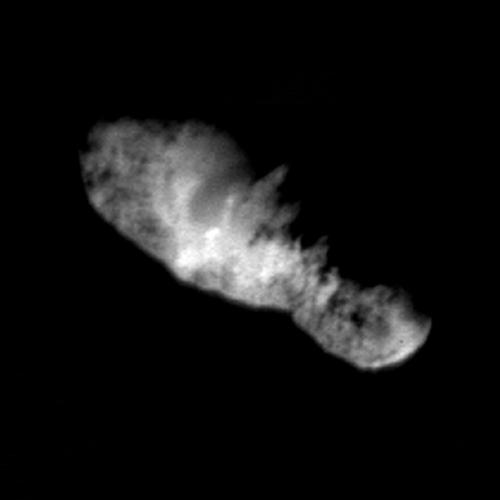
103R / Hartley 2, studied the probe Deep Impact (NASA) in 2010 (animation below), then the above mentioned visit of the comet 9P / Tempel (Tempel 1), another typical representative of a "family";

Comet 81R / Wilda, next to which the probe Stardust (NASA) was able to collect dust samples and bring them back to Earth in 2006;
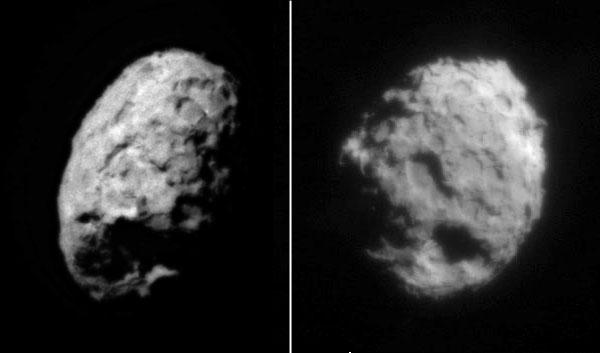
Comet 67P / Churyumov-Gerasimenko , studied probe Rozetta (ESA), as its characteristics it refers to the "family of the king" of the planets.
Then follow the family of comets, respectively Saturn, Uranus and Neptune, said first comet Halley is a typical representative of the family of comets korotkoperiodichnyh Neptune.
«Chaos" in the zone "stability» h5> Some short-period comets on the most popular version among scientists, "fly" to us from the outer limits of the Kuiper Belt - scattering disk (RD). RD with the Kuiper belt is a huge disc of icy bodies larger diameter from a few tens of meters to thousands of kilometers (Pluto and Charon). Ranging from a distance of 35 astronomical units (the orbit of Neptune) to the outer limits of the 50 AU (Or 100 AU with RD) zone has an estimated weight of 1-8 mass of the Moon (the asteroid belt is not as massive as 0, 04 mass of the moon). Actually the Kuiper belt as a whole is stable, thanks to orbital resonance with Neptune, and with each other.
The map of distribution of known Kuiper belt objects (Figure distances ae) i>
The current state of the Kuiper belt and the Oort cloud, associated with ancient migration of Neptune in the outer regions of the solar system, under the influence of the resonances of Jupiter and Saturn. Some material was ejected from the solar system, the part with the Oort cloud - in its outer parts. Millions as other debris were thrown into the inner solar system, causing late heavy bombardment 4-3, 5 billion years ago.
The solar system before the "migration" of Neptune (purple orbit) - (a), during (b) and after ©. Green denotes the orbit of Uranus i>
blockquote>
To explain the instability of the scattered disk, it is necessary to resort to the basics of celestial mechanics. The two main parameters of the orbit of a celestial body is apocentre (point of maximum distance from the surface of a planet or star in the latter case we speak of aphelion) and periapsis (closest point of the orbit, or in the case of revolution around the sun - perihelion). The difference between the values expressed in the eccentricity of the orbit - the degree of deviation from the ideal range (e = 0) to an ellipse (e & gt; 0, but & lt; 1), and further to the parabola (e = 1), and hyperbole (e & gt; 1)
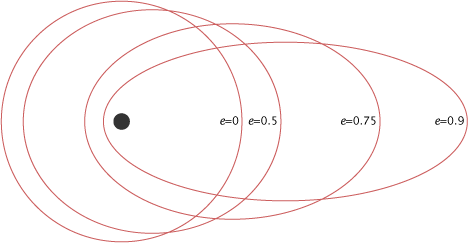
In the last two cases we are talking about the path of no return. Changing the orbit may at any point, but most of all at the aphelion is affected by changes in velocity at perihelion (the aphelion increase acceleration and decrease braking) and vice versa. And the greater the eccentricity, the greater the effect of speed changes. Moreover, the "sensitivity" of the orbit perturbations increases with its height, since the orbit is inversely proportional to the increase in the rate of falls orbital rotation of the body (the people familiar with the simulator Orbiter and KSP know this not by hearsay).
In the inner part of the solar system, in the area of terrestrial planets and the asteroid belt, the orbital velocity of the body is quite large (tens of km / s), and the relatively small eccentricities. Therefore, the strong orbital perturbations is necessary to expend a lot of energy. On the outer edge of the Kuiper belt, the scattered disc, the orbital velocities of the bodies usually range from a few kilometers to a few hundred m / s, so even small gravitational perturbations or collision greatly alter the eccentricity. Heavenly body significantly increases its aphelion (acceleration), or reduce the perihelion (braking), heading into the inner part of the solar system.
Table difference orbital velocities in the solar system? Mercury - Mars (terrestrial), Jupiter - Neptune (giants) and Pluto (the inner part of the Kuiper Belt)
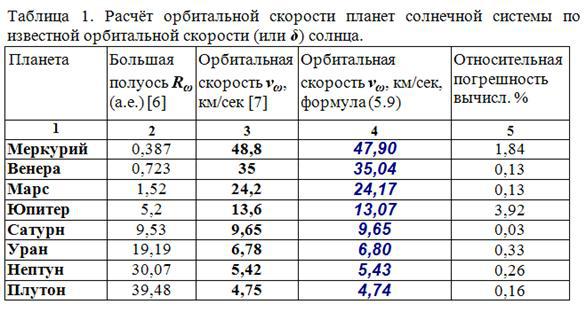
Space Truckers h5> Still on the most popular in the scientific community believe that the majority of short-period comets class P / all of the comet P / arrive to us from the alleged Oort cloud. The inner part of the cloud has the form of a toroidal belt, which stretches over a distance of 2,000 to 20,000 astronomical units (cloud Hills). The mass of this cloud estimate at least two dozen of the mass of the Earth.
The comparative sizes of the orbits of the terrestrial planets in the background of the Kuiper Belt, and accordingly the size of the latter against the backdrop of the Oort cloud i>

Cloud Hills serves as a kind of external replenishment, a spherical cloud, a mass of a few Earth masses, stretching from a distance of 20 000 AU 1 light-year, to the gravitational boundary of the solar system (the scope of the Hill). That outer Oort cloud, and is considered the main "supplier" of comets into the inner solar system. Presumably this is the remains of the primary "building blocks" of the solar system, so these objects are of great scientific interest. The effects of braking and acceleration, described to the Kuiper Belt, there are much stronger because of the extremely low orbital velocities of comets (meters per second).
Among the most well-known long-period comets of recent decades should be noted the comet C / 1996 B2 Hyakutake, C / 2006 R1 and C / 2009 P1 McNaught. Appearing to him from distant regions of the Oort cloud comets in both the first and last time, flying perihelion, ever left the solar system on a hyperbolic trajectory (eccentricity greater than 1).
C / 1996 B2 Hyakutake on the terrestrial sky i>
C / 2006 P1 McNaught ("Great Comet of 2007"), with another example of the arched "wrong" coma i>
In 2010 Comet Elenin (C / 2010 X1) had intended to do the same, but the gravitational perturbation of Jupiter "prescribe" a comet in the solar system, reducing the eccentricity of less than 1 (the aphelion is 500 AU). The famous "Big comet in 1997," Hale Bopp (C / 1995 01) is intended only to give another lap of honor at its perihelion, almost perpendicular to the plane of Earth orbits. However, the inexorable gravity of Jupiter, and this time the comet's perihelion reduced by half - from 600 (circulation period of 4,800 years) to 350 AU (circulation period of 2,400 years).
«A large comet in 1997," Hale Bopp i>
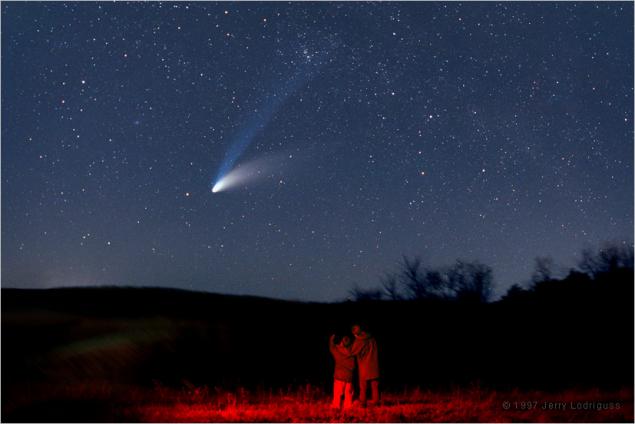
And perhaps the biggest disappointment astronomical 2013 became Comet ISON (C / 2012 S1), moving in a parabolic trajectory (e = 1) of the outskirts of the solar system, a celestial body literally fell apart when passing its perihelion.
Simulation of changes in the history of our old familiar orbit of Halley's Comet, revealed that she, too, came in a distant solar system from the Oort cloud. Gravitational perturbations of the giant planets, as is the case with many other comets, "prescribe" it to the family of comets Neptune. Aphelion of the comet's orbit just touches the Kuiper Belt (35 AU) and the perihelion passes closer than Venus in 88mln km from the sun. The next time the comet returns to perihelion in 2061.
In conclusion, I would like to recall the words of Mark Twain, as I was born in the year of the appearance of Halley's Comet (though a difference of 150 years): "I came into this world with a comet and go, too, with her when she arrives next year» © 1909 . Mr. Twain really gone in 1910, and with it, Leo Tolstoy and the famous Italian astronomer Schiaparelli. Agree, not the most boring company to explore the solar system.
Readers, I sincerely wish to live up to that momentous time, and let no man-made disasters or the death of idols will not spoil your impressions of admiration for the beauty of the famous pilgrim of space.
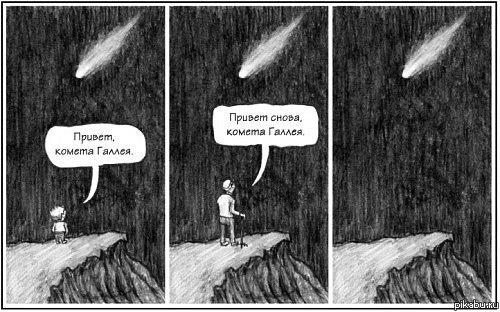
Source: habrahabr.ru/post/232631/















